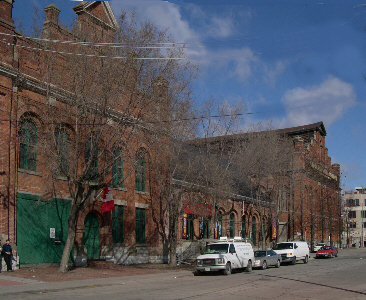The gas works that fed the lights of Edwardian Toronto was located south of Front Street between Princess and Berkeley. Two of its buildings now house CanStage’s Berkeley Street Theatre and the rehearsal halls of the Canadian Opera.

The Consumers Gas Company purchased a considerable amount of land between Front Street and the railway tracks in this part of town in 1885 and proceeded to develop it for the production of gas to light the houses and streets of late Victorian and Edwardian Toronto. The block between Princess and Berkeley housed production facilities. The land previously owned by Enoch Turner became a tank farm.

The building above that now houses the Imperial Oil Opera Theatre, 251 Front St., was Purifying House No. 2 built in 1887-1888 by the architects Strictland and Symens. It has been designated as a historic building under the Ontario Heritage Act. Standard Woollen Mills erected the building to the west (also designated as a historic building) in 1882. The architect was E.J. Lennox, the noted Toronto architect who also designed Casa Loma and the old City Hall. In 1893 an extension was joined to the woollen mill, and in 1897 a fourth floor was added to this building. The building south of the lane that now houses CanStage’s Berkeley Street Theatre Complex was a gas pumping station.
The gas produced was a mixture of coal gas, produced by the destructive distillation of bituminous coal, and water gas, produced by treating the red- hot coke from the former process with steam. The mixture contained carbon monoxide, hydrogen and methane. Coal tar and coke are by-products. This was a dangerous, explosive and poisonous mixture and accidents did occur. Houses blew up and people committed suicide by putting their heads in ovens.
As electricity became a more popular source of lighting the city, the demand for gas dropped, but production continued at this location until 1954, when natural gas was introduced. Consumers Gas Company then stopped operating here and sold its lands. The building at the south-west corner of Front and Berkeley streets passed through several hands until Dalton’s, a manufacturer of foods and household goods, purchased it in 1967. Dalton’s was founded as a soap factory in London, Ontario, in 1834 and relocated to Toronto in 1871. By 1909 the company produced “spices, coffee, extracts, mustard, jelly and lemonade powders.” In 1936, Dalton’s purchased 227 Front Street East for its head office and main processing factories, and soon became famous for its maraschino cherries.
In 1985, The Canadian Opera Company purchased the buildings north of the lane and commenced an comprehensive $10 million restoration program. The architects were Bregman, Hamann and Arcop Associates. Both federal and provincial government contributed major funding and a private fund-raising campaign raised the balance. This included a substantial gift from Joey and Toby Tanenbaum after whom the centre is named. As well as their major donation towards the restoration of the buildings, the mosaic in the box office lobby and the Max Tanenbaum Courtyard Gardens (which can be seen from the lane) were also gifts of the Tanenbaums. Phase I of The Joey and Toby Tanenbaum Opera Centre in the old gas purifying house was completed in November 1985, and houses the 450-seat Imperial Oil Opera Theatre and facilities for rehearsal, coaching, workshops and receptions. Phase II, the old woollen mill, was renovated as the administrative offices, box office, wig and make-up department, music library, archives, props workshop and costume workshop and opened Dec. 2, 1987.
The Canadian Opera is now building a new theatre at the corner of University and Queen, to be called The Four Seasons Centre for the Performing Arts, but the buildings here on Front Street will continue to house the company’s main administrative offices and rehearsal spaces and workshops.
The building south of the lane that now houses CanStage’s Berkeley Street Theatre Complex was a gas pumping station. This heritage building was converted into a centre for contemporary theatre in 1971. The Canadian Stage Company was formed in 1987, by the merger of the Toronto Free Theatre and CentreStage, and can trace its roots back over 50 years. Its mandate is to “create and produce the best in Canadian and international theatre, attracting Canada’s best writers, directors and actors.” It officially rebranded itself as “CanStage” in its 2000-2001 season. It stages plays at three locations: the Bluma Appel Theatre in the St. Lawrence Centre, here in the Berkeley Street Theatre and in the “magical” outdoor setting of the Amphitheatre in High Park.
For more about Can Stage go to www.canstage.com
For more about the Canadian Opera go to www.coc.ca
